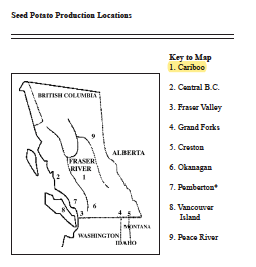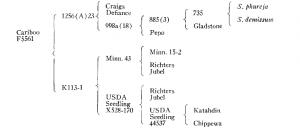Cariboo Potatoes
The Cariboo Potato is applicable to BC Food History for its name and its history of being grown in seed potato programs in BC. While it’s not a BC Heritage potato, it may become increasingly useful as climates change and some areas become drier.
The ’50s were a time of rapid plant development by both the Federal Department of Agriculture and plant breeders in Canada and the United States. The Cariboo potato was the product of the Potato Breeding Program of the Canada Department of Agriculture. It was developed at the federal Potato Research Centre in Fredericton, New Brunswick.
Each year the federal Potato Research Center sent seed potatoes out for testing at a network of experimental farms nationwide. In 1963, one variety did unusually well in central British Columbia’s tough climate and Mike Van Adrichem, then a horticulturalist with the Prince George experimental farm, named it “Cariboo”. An article in the American Potato Journal[i] in 1968 describes it as: late maturing; distinctive in appearance with pink eyes and some pink skin at the eye end; highly resistant to bruising; and with resistance to Verticillium albo-atrum (wilt) and Phoma (leaf spot rot). It also reported very good yields in the trials in the Interior of the Province of British Columbia The genealogy of the Cariboo potato was displayed like this (p. 247).
This article also shared the results of cooking and chipping trials and stated that the Cariboo was equal to Netted Gem and Kennebec for boiling, and chipping and frying, and superior to the Kennebec for baking.
With these results it was not surprising that the Cariboo was grown as seed potatoes in the area of British Columbia of the same name, designated for production of certified seed potatoes. According to the BC Bylaws, Seed Potato Act[ii], the Cariboo Certified Seed Potato Control Area is described as:
Firstly — Commencing at the point of intersection of the high-water mark of the Fraser River, on the left bank thereof, with the high-water mark of Quesnel River, on the left bank thereof; thence easterly along the said high-water mark of Quesnel River, on the left bank thereof, to the northeast corner of Lot 6686, Cariboo District; thence southerly in a straight line to the point of intersection of the easterly boundary of Lot 5038 with the centre line of Australian Creek; thence due west to a point lying 2 miles perpendicularly distant easterly from the high-water mark of the Fraser River, on the left bank thereof; thence in a general southerly direction along a line parallel to and 2 miles perpendicularly distant easterly from the said high-water mark of the Fraser River, on the left bank thereof, to the northerly production of the westerly boundary of Lot 9113; thence southerly along the said northerly production and the said westerly boundary of Lot 9113 to the northwest corner of Lot 5086; thence easterly and southerly along the northerly and easterly boundaries of Lots 5086 and 5085 to the aforesaid high-water mark of Fraser River, on the left bank thereof; thence westerly and northerly along the said high-water mark of the Fraser River, on the left bank thereof, to a point due east of the centre line of the mouth of Narcosli Creek; thence due west to the said mouth of Narcosli Creek; thence due west 2 miles; thence in a general northerly direction along a line 2 miles perpendicularly distant westerly from the high-water mark of the Fraser River, on the right bank thereof, to the high-water mark of Baker Creek, on the right bank thereof; thence easterly along the said high-water mark of Baker Creek, on the right bank thereof, to the high-water mark of the Fraser River, on the right bank thereof; thence southerly along the said high-water mark of the Fraser River, on the right bank thereof, to a point due west of the point of commencement; thence due east to the point of commencement.
Secondly — Lots 4535 and 4536, Cariboo District, commonly known as “Diamond Island” are constituted a certified seed potato control area under the name “Cariboo Certified Seed Potato Control Area”.
Sounds fairly complicated but those familiar with the territory will understand where it is. For the layperson, we can think of it as in a belt spanning from McCleese Lake, just north of Williams Lake, to Hixon, just south of Prince George.[iii]
 At one time there were 35 registered seed potato growers[iv] in the Cariboo district but in checking the BC Seed Producers Directory I couldn’t find any current growers[v]. A 2016 article in the Prince George Citizen mentioned a few growers were still around[vi]. In Quesnel 900 acres of Cariboo seed potatoes were grown at peak production[vii]. Various BC Department of Agriculture reports give the number of acres in production for various years, e.g., 1948, 543 acres and 1960, 190 acres[viii] but whether they are Cariboo potatoes is not given.
At one time there were 35 registered seed potato growers[iv] in the Cariboo district but in checking the BC Seed Producers Directory I couldn’t find any current growers[v]. A 2016 article in the Prince George Citizen mentioned a few growers were still around[vi]. In Quesnel 900 acres of Cariboo seed potatoes were grown at peak production[vii]. Various BC Department of Agriculture reports give the number of acres in production for various years, e.g., 1948, 543 acres and 1960, 190 acres[viii] but whether they are Cariboo potatoes is not given.
You might wonder why seed potatoes for Cariboo are no longer available. Alas the Cariboo fell victim to technology. What makes the Cariboo endearing to home gardeners in manual harvesting – the fact that the tubers hold on to the vine – make them a menace to mechanical harvesting as they tangle up the machinery. Because of this the Cariboo potato was decertified in 1976. Once a variety is de-listed, seed growers will lose their licence if they grow them. According to a 2009 article in the Tyee, Jerry LeBourdais, a Cariboo resident searching out Cariboo potatoes wrote to the Ministry of Agriculture in 1982 and was told, “the variety Cariboo can no longer be sold under any name and cannot be grown as seed.” The letter continued: “I suggest that you select and grow varieties that can be legally grown in Canada.”[ix]
Of course, that doesn’t stop intrepid home gardeners. Through backyard sharing, the Cariboo potato, an outlaw, is still hiding out in the land of frontier spirit.
[i] Maurer, A. R., Van Adrichem, M., Young, D. A., & Davies, H. T. (1968). American Journal of Potato Research, 45(7), 247-249.]
[ii] BC Seed Potato Act, Seed Potato Regulations 219/84 and 237/59 http://www.bclaws.ca/civix/document/id/loo88/loo88/10_237_59]
[iii] Will, J. (2009, Oct. 29). The Potato Underground: How the ‘outlaw’ Cariboo spud, once blacklisted by Agribiz Advocates, was Saved The Tyee. http://thetyee.ca/Life/2009/10/29/PotatoUnderground/
[iv] ibid
[v] https://bcseedpotatoes.com)
[vi] Adams, A. (2016, April, 28). Honouring a Trail Blazer. Prince George Citizen. https://www.princegeorgecitizen.com/opinion/columnists/honouring-a-trail-blazer-1.2241469
[vii] https://www.memorybc.ca/cariboo-certified-seed-potato-growers-association
[viii] Province of British Columbia (1949). Report of the British Columbia Department of Agriculture. Victoria, BC: Kings Printer; Province of British Columbia (1960). Report of the British Columbia Department of Agriculture. Victoria, BC: Queens Printer
[ix]Will, J. (2009, Oct. 29). The Potato Underground: How the ‘outlaw’ Cariboo spud, once blacklisted by Agribiz Advocates, was Saved The Tyee. http://thetyee.ca/Life/2009/10/29/PotatoUnderground/; http://www.horselakefarmcoop.ca/ceeds/cariboo-potato.html
UPDATE: The following CBC news article is by Jordan Tucker. It refers to the BC Food History Network as “a group of university instructors”. BCFHN is in reality three home economists, and the “university instructors” is an aside. The article was written by Dr. Mary Gale Smith.
https://www.cbc.ca/news/canada/british-columbia/bc-farmers-outlaw-potatoes-1.7051637


